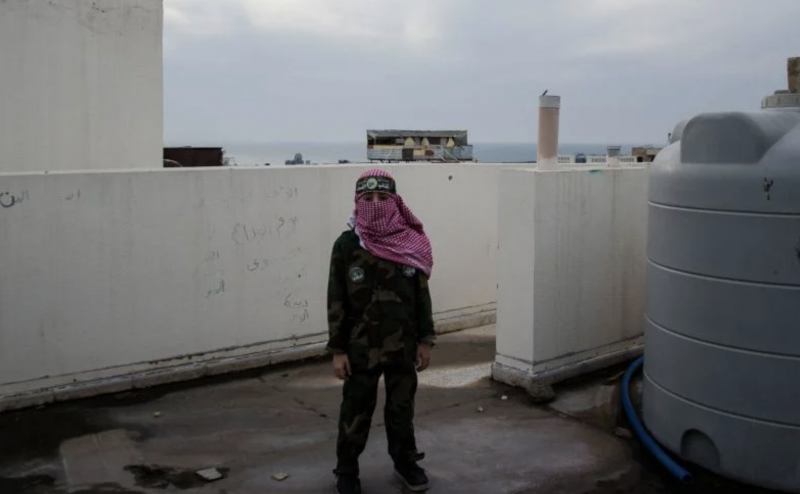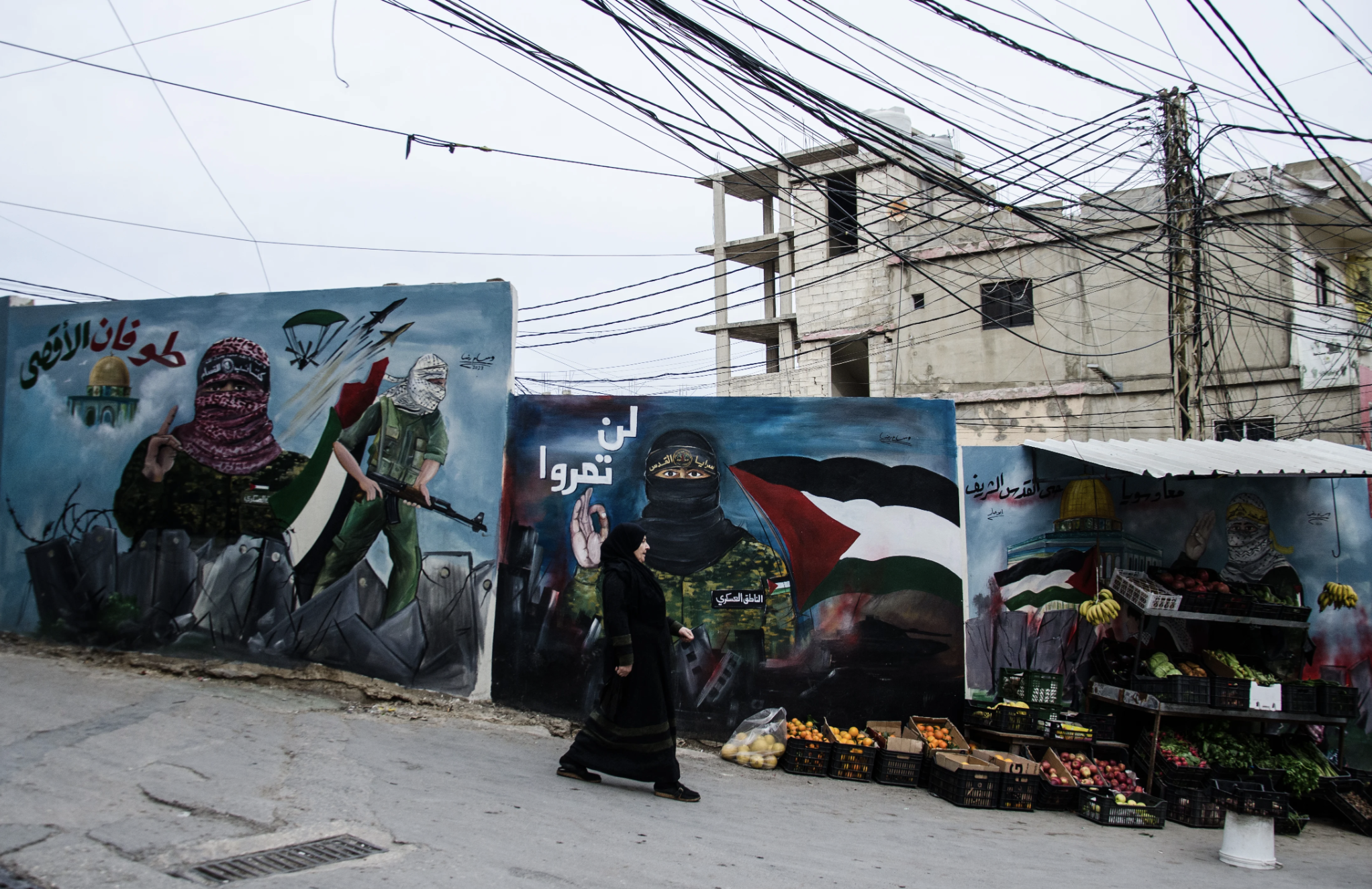
Abdallah, nicknamed "Abou Obeida of Nahr al-Bared," on the roof of his house in the Palestinian refugee camp of Nahr al-Bared. (Credit: Emmanuel Haddad/L'Orient-Le Jour)
With Saleh al-Arouri’s targeted assassination, in Beirut's southern suburbs on Tuesday Jan. 2, the Islamist movement's presence in Lebanon is under the spotlight. Its influence is particularly strong in the 12 Palestinian refugee camps scattered across the country, from Burj al-Shemali in the south, where one of the inhabitants, Ahmad Hamoud, was killed yesterday in the Israeli strike, to Nahr al-Bared in the north, where Abu Obeida, the spokesman for Hamas's armed wing, has more emulators than ever.
Over there, eight-year-old Abdallah Abdel Razeq, nicknamed the "Abu Obeida of Nahr al-Bared,” punctuates his sentences by pointing his index finger straight up at the sky, like his idol, whose warrior speeches he memorizes one after the other. His face is masked by a red koufiyyeh encircled by an Ezzedine al-Qassam Brigades headband, his frail body clad in military fatigues. "And we can confirm that we have targeted seven [Israeli] military units with rockets and improvised explosive devices in the Shuja'iya district," he chants in a video proudly shown by his uncle Mohannad in the family apartment in Nahr al-Bared, 16 km north of Tripoli.
In the alleys of the camp, surrounded by Lebanese army roadblocks, the masked face of Abou Obeida, spokesman for the armed wing of Hamas, is everywhere. Plastered on the cracked walls, his photo is captioned with his shock expressions or the title “Palestinian Defense Minister.” Murals depict him decked out in the trappings of armed Palestinian resistance, from the national flag to the Qassam rockets and the paragliders of the al-Aqsa Flood operation which, in the eyes of the camp's disillusioned youth, made Abou Obeida a role model.
 A mural depicting Abou Obeida and Operation al-Aqsa Flood in Nahr al-Bared. (Credit: Emmanuel Haddad/L'Orient-Le Jour)
A mural depicting Abou Obeida and Operation al-Aqsa Flood in Nahr al-Bared. (Credit: Emmanuel Haddad/L'Orient-Le Jour)
A mural depicting Abou Obeida and Operation al-Aqsa Flood in Nahr al-Bared. (Credit: Emmanuel Haddad/L'Orient-Le Jour)
Yet little is known about the life of this “herald.” According to Marie Kortam, associate researcher at the Institut Français du Proche-Orient (IFPO), it's this veil of mystery that makes him so popular: “We have no certainty about his identity. This unknown person creates a magical effect around him,” she said. According to the BBC, all we know is that he takes his pseudonym from Abou Obeida Ibn al-Jarrah, one of the Prophet's companions, and wears the red kouffiyeh in homage to Imad Akel, the Hamas military leader killed by Israel in 1993.
On Oct. 25, Arabic-speaking Israeli army spokesperson Avichay Adraee said on X (formerly Twitter) that Israel had revealed his identity. “This is the first name Hudhayfah Kahlout, who hides behind the nickname Abou Obeida and who also hides behind his red kouffiyeh.” Hamas denied this claim. The Israeli daily Yediot Aharonot said that Abou Obeida originates from the village of Iliya in Gaza, whose inhabitants were expelled during the Nakba, and that he lived in Jabalia, in the north of the enclave. One thing is certain, according to Marie Kortam: “...unlike the political leaders of Hamas, who are based abroad, Abou Obeida is a product of the siege of Gaza, and people can sense this. Even those who don't support Hamas respect him for that.”
‘Oct. 7 generation’
In a noisy sidewalk café in the camp, Abed, a young construction worker, said that Oct. 7 was “an electroshock.” Before then, “we were focused on our own problems, especially since the financial crisis” that has been raging in Lebanon since 2019, explained the man who describes his work, which pays around $10 a day, as “modern-day slavery.” Since then, “Palestine has been at the heart of my concerns,” he said. Abou Obeida is its pulse. “When my friends and I hear that he's going to speak, we get ready in the morning to watch him. And afterwards, we analyze all his sentences together,” he continued.
They're not the only ones. “Some of his expressions have become trends on social networks, such as 'La samah Allah' ['God forbid'],” Abed said. “We're not asking you to defend the children of Gaza with your armies and tanks, God forbid,” he sardonically said on Oct. 28, addressing Arab countries that had remained virtually silent since the start of Israel's deadly counter-offensive.
 Abou Obeida's portrait on a wall in the Nahr al-Bared camp. (Credit: Emmanuel Haddad/L'Orient-Le Jour)
Abou Obeida's portrait on a wall in the Nahr al-Bared camp. (Credit: Emmanuel Haddad/L'Orient-Le Jour)
Abou Obeida's portrait on a wall in the Nahr al-Bared camp. (Credit: Emmanuel Haddad/L'Orient-Le Jour)
Then there's his scathing tone, and his regular announcements of the losses inflicted on the Israeli army by the al-Qassam Brigades and other Palestinian armed groups engaged in the Gaza conflict. This is enough to lift the spirits of the Nahr al-Bared refugees, powerless spectators of Israel’s counter-offensive which, according to the latest Hamas figures, has already claimed almost 22,000 Palestinian lives, and wounded more than 57,000. “Abou Obeida is an icon for us,” said Bilal, Abdallah's other uncle. “When we're depressed by the images of unprecedented destruction in Gaza, his speeches give us the courage and strength to believe,” said the 39-year-old, who, like most of the camp's 30,000 or so inhabitants, is unemployed.
His brother Mohannad, 34, a tall, sad-eyed man who is also unemployed, stared expectantly at his nephew Abdallah with his happy teeth, curly hair and serious expression. “While Israel is trying to destroy an entire generation by targeting children, we're educating our children to the idea that their presence in Lebanon is temporary,” he said, pointing out that their family hails from the village of Aamqa, in Israel's northern Acre province, from which his forebears were expelled during the Nakba in 1948. “Maybe the generation of Oct. 7 will be the generation of return,” he said.
‘The great dream of return’
Bilal said “Hamas does not attack civilians,” even though the facts prove him wrong. But this explains why 72% of Palestinians support the Hamas attack, according to an opinion poll released on Dec. 14 by the Palestinian Center for Policy and Survey Research. According to the poll, only 10% believe that Hamas has committed war crimes. Bilal insisted on the various surveys, broadcast notably by the Israeli daily Haaretz, which have revealed that Israel was behind the deaths of Israeli civilians on that fateful day, and on the daily massacres perpetrated by Israel in Gaza. Upset by these horrors, little Abdallah's entire family was mobilized to produce the “Abu Obeida of Nahr al-Bared” videos: “His father wrote the speeches for him, and his aunt filmed and directed,” explained Mohannad.
Abou Obeida's influence extends beyond the barbed-wire walls of Nahr al-Bared. In the neighboring Beddawi camp, which L’Orient-Le Jour also visited, the presence of his masked portrait far exceeds that of former figures of the Palestinian cause. As for the Ain al-Hilweh camp, on the outskirts of Saida, a café serves hot drinks in mugs bearing the effigy of the man in the red kouffiyeh, according to the Campspost media... “Abou Obeida embodies the figure of the resistant leader that has been missing since the death of Yasser Arafat, or even before, since the signing of the Oslo Accords in 1993, considered a renunciation by many Palestinians. With his kouffiyeh, his support for the armed struggle and his lofty words, he crystallizes all the imagination that a resistance movement can convey,” said Kortam.
If the young people of Nahr al-Bared identify with his warlike rhetoric, it's also because “every act of resistance brings them closer to their great dream: To return home,” said a Palestinian refugee who preferred to remain anonymous. “Resistance is the Palestinian refugees’ guarantee that someone is fighting for their return. You can live in Lebanon for a thousand years, but you'll never have the same rights as in your own country,” explained Mohannad. In the “General and Political Principles” document written in 2017 as a supplement to its 1988 charter, Hamas rejects the Oslo Accords. They believe that “the establishment of a Palestinian state ... according to the June 4, 1967 borders with the return of refugees and displaced persons to their homes from which they were expelled, is a formula for national consensus.”
‘Why not take up arms?’
When asked what he wants to be when he grows up, Abdallah had only one word: “Fighter.” When asked why, he said, “because Israel is occupying our land.”
“The Palestinian fighters killed in southern Lebanon are children from the camps and groups,” said the above-mentioned source, referring to the three Hamas members killed on Oct. 14 by Israel after trying to cross the border.
However, the Nahr al-Bared camp has been disarmed since the 2007 conflict between the Islamist group Fatah el-Islam and the Lebanese Army, during which 27,000 refugees were displaced, their homes razed by bombs and then targeted for looting and vandalism, according to Amnesty International. When Hamas called on refugees at the beginning of December to join “the youth of the al-Aqsa Flood … thousands of young people from the camp registered,” said Mohannad, specifying that the aim is above all to inculcate “the spirit of resistance.” This does not mean that they will become members of Hamas, “...a long and complex process that takes at least three years, while Fatah immediately provides its members with a monthly sum of money,” added the Palestinian source. However, his eldest son Bilal is ready to go further: “Why not take up arms? Israel is shelling southern Lebanon and threatening the Palestinian camps in Lebanon. We need to prepare ourselves,” he said.
This article was originally published in L'Orient-Le Jour.